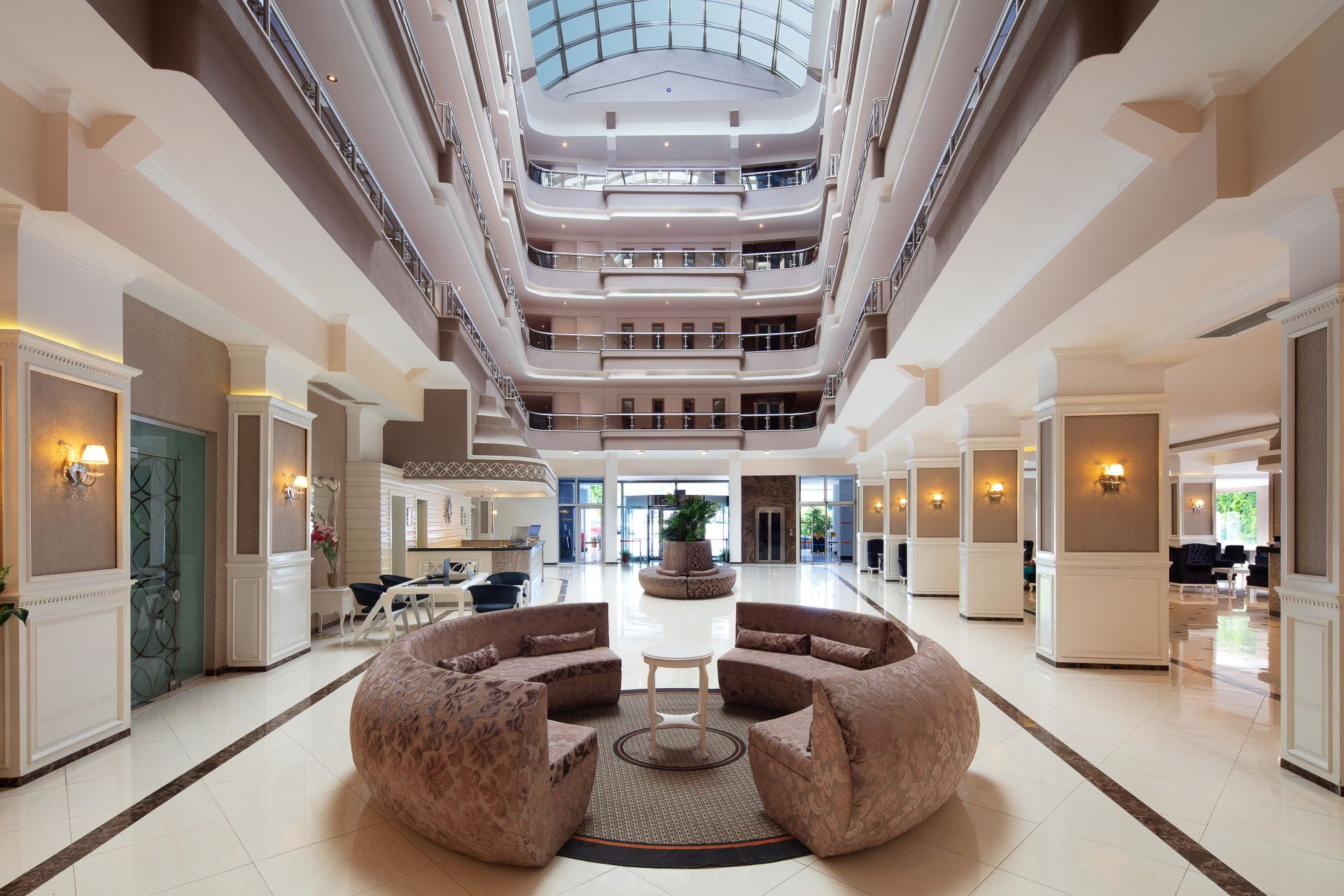
A hotel lobby is the showcase of the property. Everything guests see, feel, and smell the moment they step in shapes their first impression of the hotel. Therefore, the lobby should be designed not only with stylish furniture, artwork, or lighting but also with silent, healthy, and aesthetically pleasing ventilation solutions.
So, how can a lobby have a ventilation system that is quiet, efficient, and visually appealing?
1. Challenges of Lobby Areas
Lobbies are among the busiest and most complex areas of a hotel. Ventilation systems must address multiple parameters:
-
Heat loss or gain due to continuous guest traffic
-
High CO₂ levels caused by crowded spaces
-
Cold drafts in winter and heat accumulation in summer
-
Need for silence, as lobbies often include reception, waiting, and greeting areas
-
Architecturally significant ceiling structures, aesthetic details, and lighting elements
A system designed with all these considerations not only functions efficiently but also enhances the guest experience.
2. Silence: The Invisible Face of Comfort
Hum, fan noise, or sudden bursts of air from lobby ventilation directly affect guest comfort. Noisy systems:
-
Make conversations difficult
-
Affect the work of reception staff
-
Undermine the perception of luxury
-
Create an impression of a poorly maintained facility
Solutions:
-
Use of low-speed, high-efficiency fans
-
Sound-absorbing ducts and acoustically insulated diffusers
-
Acoustic silencers inside ducts
-
Selection of quiet fan-coil or air handling units (AHU)
-
Mechanical rooms located away from the lobby with air only delivered to the space
A quiet ventilation system is one of the most appreciated elements that guests notice subconsciously.
3. Aesthetic Integration: Invisible, Subtle Air Distribution
Ventilation grilles, diffusers, and duct systems in the lobby are often visible. In modern design, invisible technology takes precedence. Aesthetic solutions should perform their function without disrupting spatial perception.
Design-friendly solutions:
-
Linear slot diffusers: Slim and elegant, compatible with modern ceilings
-
Concealed ceiling systems: Only narrow grilles are visible
-
Hidden discharge solutions: Integrated into wood or stone panels
-
Underfloor systems providing upward airflow
-
Custom grille finishes matching the ceiling or color scheme
Especially in high-ceiling contemporary lobbies, hidden air systems enhance the architectural value.
4. Air Distribution: Right Place, Right Intensity
Incorrectly planned airflow in the lobby disrupts comfort and wastes energy. Strong drafts disturb guests, while weak circulation creates a stuffy feeling.
Best practices for optimal air distribution:
-
Avoid direct air discharge over seating areas
-
Use air curtains around entrance doors
-
Choose velocity-controlled diffusers based on ceiling height
-
Airflow should not interfere with reception computer systems
-
Ensure a proper balance between fresh air and exhaust; maintain positive pressure
This ensures guests enjoy a comfortable and healthy environment.
5. Integration with Smart Hotel Systems
Next-generation hotel automation allows ventilation systems to operate in an integrated structure. Lobby air can be automatically optimized in real time.
Smart control examples:
-
Fan speed increases automatically when CO₂ levels rise
-
More fresh air during peak times (check-in/check-out)
-
Air curtain activates automatically when the entrance door remains open
-
Works with energy management systems for maximum efficiency and minimum consumption
Automation ensures the lobby maintains the correct temperature, air quality, and humidity at all times.
6. Odor and Air Purity: Keep the First Impression Clean
The first impression in the lobby is not only visual but also olfactory. Crowds, luggage handling, outdoor air, and blocked AC systems can cause unpleasant odors.
Recommendations for odor control and air purification:
-
Fresh air systems with activated carbon filters
-
Cleaning supported by plasma, ionization, or UV-C technologies
-
Regular cleaning of AHU drainage systems
-
Ozone cleaning of AHUs and ducts
-
Annual hygienic cleaning of AC ducts
-
Filtered air barriers near entrance doors to block outdoor smoke
Remember: clean air is odorless and imperceptible but ensures guest satisfaction.
Silent, Clean, and Stylish Reception Area
The hotel lobby is not just a transition space; it is a live representation of your brand. Air comfort, silence, and aesthetic details determine how guests evaluate your hotel from the first moment.
Design details, quality furniture, and luxurious ambiance should be supported by a ventilation system that is unseen but felt. A flawless experience begins not only with sight but also with breathing.
İlker KURAN
Alperen Mühendislik Ltd. Şti.







